“The advantages of EDM drilling are evident in its exceptional material removal rates and minimal thermal damage. It offers a unique solution for processing hard-to-machine materials like titanium and hardened steel.”
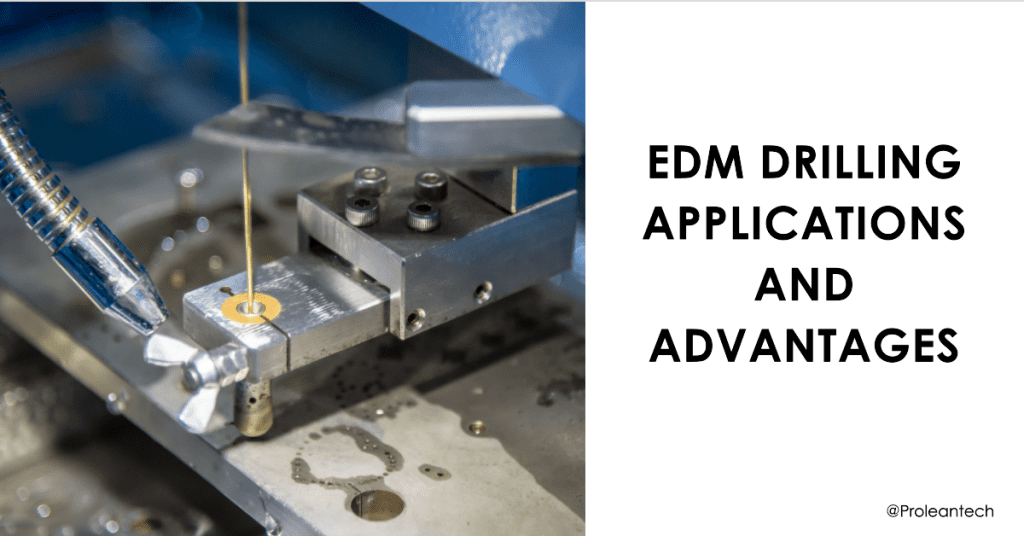
It is challenging to drill hard materials like hard steel and titanium with CNC drilling and other traditional methods. However, Electrical Discharge Machining (EDM) can drill these materials. EDM drilling applications are ideal for precise holes in various materials, primarily metals and conductive materials. The demand for EDM drilling has significantly increased over the years, owing to its numerous advantages over traditional drilling methods.
This article explains the EDM drilling process, its applications, and its benefits. We will also compare this drilling with traditional methods, identify industries that can benefit, and offer tips for optimizing the process.
The Basics of EDM and EDM Drilling Applications

Small hole drilling EDM
Let’s discuss how EDM drilling works and what the crucial factors affecting the EDM drilling process;
How Does EDM Drilling Work?
In the EDM drilling process, a thin, cylindrical electrode made of a conductive material such as brass, copper, or tungsten is used to create a hole in the workpiece. The electrode is connected to a power supply, which generates a series of electrical pulses. These pulses create an electrical field between the electrode and the workpiece, causing the material at the point of contact to heat up and eventually vaporize.
As the electrode is slowly advanced towards the workpiece, the vaporized material is flushed away by a continuous stream of dielectric fluid, typically deionized water or oil. This process continues until the desired hole depth is achieved. The high level of control over the electrical pulses and the electrode’s precise positioning allows for creating highly accurate and consistent holes.
Factors Affecting the EDM Drilling Process
Several factors can influence the quality and versatility of EDM machining, such as the power settings, electrode material, and dielectric fluid used. The power settings, including voltage and frequency, determine the amount of energy transferred to the workpiece and can affect the speed and precision of the drilling process. The electrode material plays a crucial role in the electrode’s wear rate and the overall quality of the hole. Lastly, the dielectric in EDM helps to stabilize the electrical discharges and remove the vaporized material, ensuring a clean and accurate hole.
Try Prolean Now!
What are the Various EDM Drilling Applications?
The precision and accuracy of EDM offer numerous drilling applications across various industries, including aerospace, automotive, medical, and electronics manufacturing. Some applications of EDM drilling include:
1. Cooling Holes in Turbine Blades
Precise cooling holes are required in turbine blades for the aerospace industry to maintain structural integrity and prevent overheating. EDM drilling creates these holes with high accuracy and minimal material damage, ensuring the longevity and reliability of the turbine blades.
2. Wire Thread Hole Creation
EDM drilling creates small, precise holes in materials such as hardened steel that are difficult or impossible to drill using traditional methods. These holes are commonly used for wire threading applications in the automotive and aerospace industries.
3. Vent Holes
EDM drilling creates small, shallow vent holes in materials such as plastic or rubber. These holes are commonly used in electronic devices to allow for air or gas flow while maintaining a sealed enclosure.
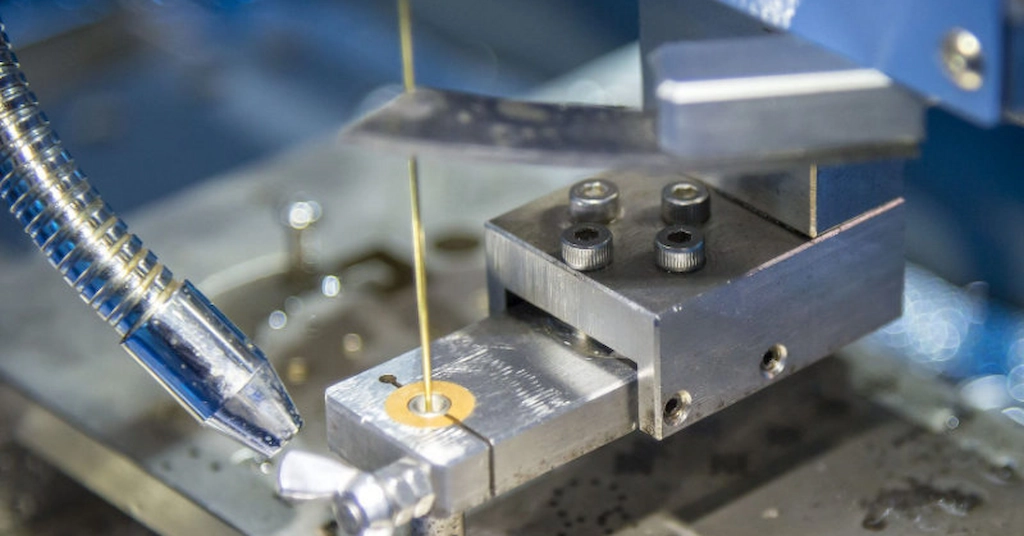
Wire thread hole with EDM
Types of EDM Drilling Machines
1. Drill EDM
Drill EDM machines are designed for the EDM deep hole drilling process and are ideal for creating small, deep holes in conductive materials. These machines use a rotating spindle to hold and advance the electrode toward the workpiece, providing a high level of accuracy and control. Drill EDM machines are commonly used in industries such as aerospace, automotive, and medical manufacturing, where precision is critical.
2. EDM Hole Drilling
EDM hole drilling machines, also known as hole poppers or small hole EDM machines, are designed to produce small, shallow holes in conductive materials. These machines use a stationary electrode and apply pressure to the workpiece to create the hole. EDM hole drilling machines are typically used for applications such as wire threading, vent hole creation, and other instances where small, shallow holes are required.
Related: Emerging Trends in EDM Technology: Shaping the Future of Precision Machining
Components of an EDM Drilling System
EDM drilling is accomplished through the collaboration of several components and systems, including power supply, electrode, control system, and others.
Table: EDM Drilling Applications
| Component | Description | Function |
| Power supply | Provides electrical energy for the process. | Generates controlled electrical pulses transmitted to the electrode, creating electrical discharges. |
| Electrode | Responsible for creating the hole in the workpiece. Made of conductive material like brass, copper, or tungsten. | Selected based on the material being drilled and the desired hole size and shape. |
| Dielectric fluid system | Flushes away the vaporized material and helps stabilize the electrical discharges. | Typically deionized water or oil, is delivered to the drilling area through a nozzle or electrode tube. |
| Control system | Manages the EDM drilling process, including electrode speed, power settings, and dielectric fluid delivery. | Provides precise control over the drilling process, ensuring accuracy and consistency. |
Related: EDM vs Milling: Unveiling Key Differences in a Comprehensive Comparative Study
Try Prolean Now!
Advantages of Using EDM Drilling
EDM drilling technology offers numerous advantages over traditional drilling methods, including:
- Improved accuracy and precision: EDM drilling offers a high level of accuracy and precision, allowing for the creation of highly complex shapes and patterns. The non-contact process prevents material damage and distortion, resulting in consistent and accurate hole dimensions.
- Versatility: EDM drilling can create holes in a wide range of materials, including hardened steel, titanium, and ceramics. It can also create holes of various sizes and shapes, making it a versatile solution for many manufacturing applications.
- Reduced machining time: EDM drilling can create holes much faster than traditional drilling methods, as it does not require the use of multiple tools or extensive setup time.
- Cost savings: EDM drilling can reduce the overall cost of manufacturing, as it eliminates the need for expensive tooling and reduces material waste.
Comparing EDM Drilling Applications with Traditional Methods
While traditional drilling methods such as drilling and tapping can create holes in conductive materials, they have several limitations compared to EDM drilling technology.
| Comparison | Traditional Drilling | EDM Drilling |
|---|---|---|
| Material Damage | Can cause distortion, heat-affected zones, and surface cracking. | The non-contact process does not cause any material damage or distortion. |
| Hole Geometry | Limited ability to create complex geometries, such as angled or curved holes. | Can create holes of virtually any shape or size, making it a versatile solution for many manufacturing applications. |
| Tool Wear | Require frequent tool changes and maintenance, resulting in downtime and increased costs. | Uses a single electrode to create multiple holes, reducing the need for tool changes and maintenance. |
Industries Benefits and Applications of EDM Drilling
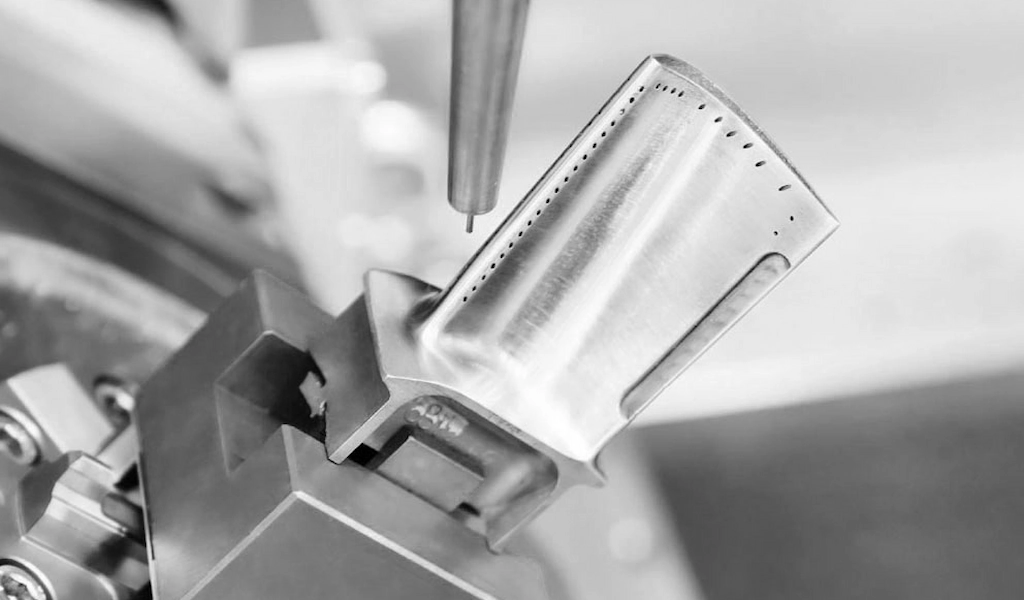
Cooling hole with EDM drilling
EDM drilling technology offers numerous benefits to various industries, including:
1. Aerospace
The aerospace industry requires high-precision components and structures that can withstand extreme conditions. EDM drilling technology can create cooling holes in turbine blades and other critical components, ensuring their longevity and reliability.
2. Automotive
The automotive industry requires precise components that can withstand high-stress environments. EDM drilling technology can create wire thread holes and other small, precise holes in materials such as hardened steel, ensuring the reliability and durability of automotive components.
3. Medical
The medical industry requires precise and reliable components for medical devices and implants. EDM drilling technology can create holes in materials such as titanium and ceramics, ensuring the accuracy and consistency of medical components.
4. Electronics
The electronics industry requires small, precise holes in materials such as plastic and rubber for venting and sealing applications. EDM drilling technology can create these holes with high accuracy and consistency, ensuring the reliability and performance of electronic devices.
Read more: EDM (Electrical Discharge Machining) in Medical Device Manufacturing
Tips for Optimizing EDM Drilling Process
To ensure the best results from your EDM drilling process, consider the following tips:
- Material selection: Choose the appropriate material for your EDM drilling application. Different materials have different conductive properties and hardness levels, which can affect the drilling process.
- Electrode selection: Select the right electrode material and shape for your drilling application. The electrode material should have good electrical conductivity and be resistant to wear.
- Optimize drilling parameters: Adjust the drilling parameters, such as voltage, current, and discharge duration, to optimize the drilling process.
- Dielectric fluid management: Ensure proper management of the dielectric fluid throughout the drilling process. Monitor the dielectric fluid level, maintain cleanliness by using effective filtration systems, and replenish or replace the fluid as needed.
- Maintain machine cleanliness: Keep the EDM drilling machine clean and free from debris. Regularly clean the work area, remove any accumulated chips or debris, and inspect and clean the electrode and tooling system.
- Regular maintenance and calibration: Schedule regular maintenance and calibration of the EDM drilling machine to ensure its optimal performance. Follow the manufacturer’s recommendations for maintenance tasks such as lubrication, alignment checks, and electrical system calibration.
- Operator training and expertise: Provide comprehensive training to the operators who will be handling the EDM drilling process. Ensure they have a thorough understanding of the machine’s operation, safety protocols, and troubleshooting techniques.
Related to: Materials Suitable for EDM Process
Try Prolean Now!
Automotive EDM Drilling Applications
EDM drilling is essential in automotive manufacturing for its precision and versatility. It creates complex shapes and fine details in hard-to-machine materials. This capability is critical for producing high-performance automotive components with tight tolerances and specific geometries.
Table: Application Examples in Automotive EDM Drilling
| Component | Description | Function |
| Fuel Injector Nozzles | Small, high-precision holes | Optimizes fuel flow for better combustion efficiency |
| Cooling Holes in Pistons | Intricately placed holes | Enhances engine cooling, preventing overheating |
| Gear Components | Precise internal contours and shapes | Improves gear performance and longevity |
| Turbocharger Components | Complex shapes with high aspect ratios | Ensures optimal airflow and turbo efficiency |
Related: Electrical Discharge Machining: Types and Applications
Conclusion
In conclusion, EDM drilling is a versatile and advanced drilling technique that offers numerous advantages over traditional drilling methods. With its ability to create precise holes in various materials and its flexibility in drilling complex geometries, EDM drilling has revolutionized the manufacturing industry.
By understanding the EDM drilling process, exploring its applications and benefits, and optimizing the drilling process using the provided tips, EDM manufacturers can harness the full potential of EDM drilling to enhance productivity and achieve superior drilling results.
When it comes to EDM drilling and EDM Machining services, ProleanTech stands out as a reliable partner that combines cutting-edge technology, expertise, and a customer-centric approach. Their commitment to precision and perfection makes them a trusted choice for industries seeking high-quality EDM drilling solutions.
FAQ’s
What are the main differences between EDM drilling and traditional drilling methods?
EDM drilling uses electrical discharges to remove material, while traditional drilling methods rely on mechanical force. EDM drilling can achieve higher precision, drill through hard materials, and create complex hole shapes that are difficult with conventional drilling.
Can EDM drilling be used for non-conductive materials?
EDM drilling is primarily used for conductive materials. However, advancements in EDM technology have allowed for limited applications on non-conductive materials by introducing conductive coatings.
What is the typical tolerance that can be achieved with EDM drilling?
EDM drilling can achieve high tolerances, often in the range of micrometers. The achievable tolerance depends on factors such as material properties, electrode size, and drilling parameters.
Is EDM drilling suitable for high-volume production?
EDM drilling is typically more suitable for low to medium-volume production or applications that require high precision. However, advancements in automation and process control have improved its efficiency, making it viable for certain high-volume production scenarios.
What industries can benefit from EDM drilling?
EDM drilling finds applications in various industries, including aerospace, automotive, medical device manufacturing, mold making, oil and gas, and electronics. It is particularly beneficial in industries that require intricate designs, complex hole shapes, and high precision.
How can I optimize the EDM drilling process for cost efficiency?
To optimize the EDM drilling process for cost-efficiency, consider factors such as material selection, electrode design, parameter optimization, and efficient use of dielectric fluid. Consult with EDM drilling experts to determine the most cost-effective approach for your specific application.

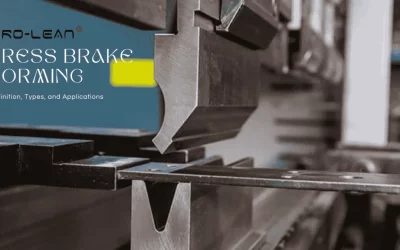
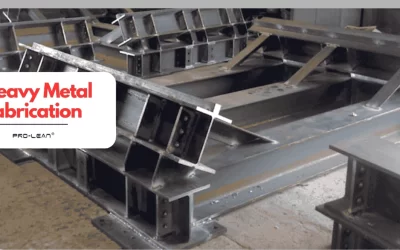
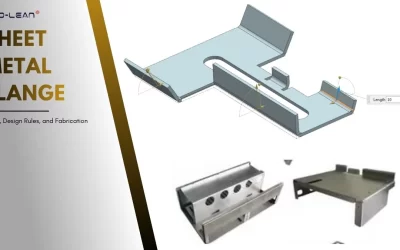
0 Comments